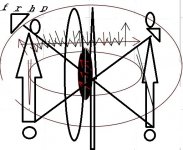The "inked circle" (AKA, the bottom rim of the rolling barrel) is in a plane perpendicular to the spin axis. The spin axis direction is determined from the vector sum of the roll and sidespin angular velocity vectors. The axis of rotation for the roll (topspin) vector is horizontal, and the axis of rotation for sidespin is vertical. The vector combination of these two components gives the total spin rate and the resultant axis of rotation of the ball (AKA, the barrel axis). The forward speed of the ball is:
v = w*r
where w is the total spin rate, and r is the perpendicular distance from the contact point (between the ball and the cloth) to the resultant spin axis, given by:
r = R*sin(A)
where R is the radius of the ball and A is the angle of the tilt axis from the vertical. So the speed of the ball is related to the spin rate and axis tilt angle according to:
v = w*R*sin(A)
For a ball rolling forward with no sidespin (i.e., horizontal spin axis: A=90 deg), v=wR; and for a ball spinning in place (i.e., vertical spin axis: A=0 deg), v=0.
The resultant spin is related to the roll spin rate (wr) and sidespin rate (ws) according to:
w = sqrt(wr^2 + ws^2)
and the tilt axis is given by:
A = atan(wr/ws)
I think what you are asking about is the spin ratio (SR) of dimensionless translational speed (which is the roll rate wr) to the sidespin rotational speed (ws):
SR = wr/ws = tan(A)
As you point out, SR=1 when wr=ws, where the tilt axis is 45 deg. However, this ratio does not vary linearly with tilt angle.
Sorry about all of the math, but that seemed to be the best way to answer your questions clearly.
Regards,
Dave
